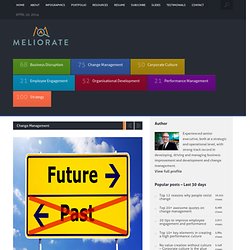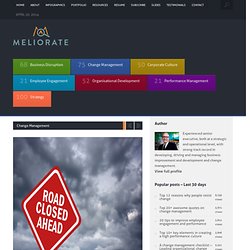

Communication is paramount when it comes to change management. It’s against human nature to react favorably to change because it takes people out of their comfort zone.

How have you seen people react to changes in their work? The typical reaction is resistance. Such resistance can often sabotage the best efforts of management to drive change throughout the organization. It even happens when managers are diligent communicators and active in the communication process. When change initiatives fail, the culprit is often a lack of good communication from management. In designing the communication phase, you are beginning to prepare your organization for the transformation from current state, or practice, to the future state. The nature of the transformational change itself Why is my company changing the way it’s always done business, and why is the change necessary? The process of changing from the current state to the future state.
Business Improvement, Change Management & Performance Group News. Process Excellence Network. The 10 Principles of Change Management. Way back when (pick your date), senior executives in large companies had a simple goal for themselves and for their organizations: stability.

Shareholders wanted little more than predictable earnings growth. Because so many markets were either closed or undeveloped, leaders could deliver on those expectations through annual exercises that offered only small modifications to the strategic plan. Prices stayed in check; people stayed in their jobs; life was good. Market transparency, labor mobility, global capital flows, and instantaneous communications have blown that comfortable scenario to smithereens. In most industries — and in almost all companies, from giants on down — heightened global competition has concentrated management’s collective mind on something that, in the past, it happily avoided: change. This presents most senior executives with an unfamiliar challenge.
Many senior executives know this and worry about it. 1. 20 tips to improve employee engagement and performance. High levels of employee engagement in an organization are linked to superior business performance, including increased profitability, productivity, employee retention, customer metrics and safety levels.

That’s way we all want employees to be engaged at work, right? But how can we actually get there? Talkline – Blind Date – Employee engagement and performance Here are 20 tips: #1 – Communicate clear goals and expectations to your employees The majority of employees want to be a part of a compelling future, want to know what is most important at work and what excellence looks like. . #2 – Share information and numbers Let them in on what is going on within the company as well as how their jobs contribute to the big picture. . #3 – Encourage open communication You can get insight into what things are important to the employee by using surveys, suggestion boxes and team meetings. . #4 – Not communicating or communicating late can damage engagement. 14 key change management elements. Change rarely comes easily Change is an inevitable part of the modern business environment.

But change rarely comes easily. Organizations, and the people within them, must constantly re-invent themselves to remain competitive. As a result, today’s leaders must do more than manage the status quo – leaders must be champions in change readiness – the ability to continuously initiate and respond to change in ways that create advantage, minimize risk, and sustain performance.
Here are 14 tips: #1 – Resistance to change Expecting resistance to change and planning for it from the start of your change management progamme will allow you to effectively manage objections. Influencing employee motivation and engagement. A new global analysis from Mercer – conducted among nearly 30,000 employees in 17 geographic markets between the fourth quarter of 2010 and the second quarter of 2011 - reveals that non-financial factors play a prominent role in influencing employee motivation and engagement.

Influencing employee motivation and engagement Employees worldwide say that being treated with respect is the most important factor, followed by work/life balance, type of work, quality of co-workers and quality of leadership (see figure). While other financial factors, such as benefits and incentive pay, can be important to other aspects of the employment deal – such as attracting, retaining and rewarding employees – Mercer’s research shows they are considered less important by employees when it comes to their day-to-day motivation and engagement at work.